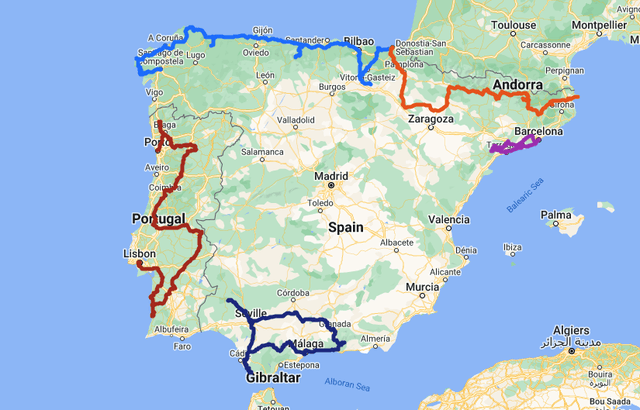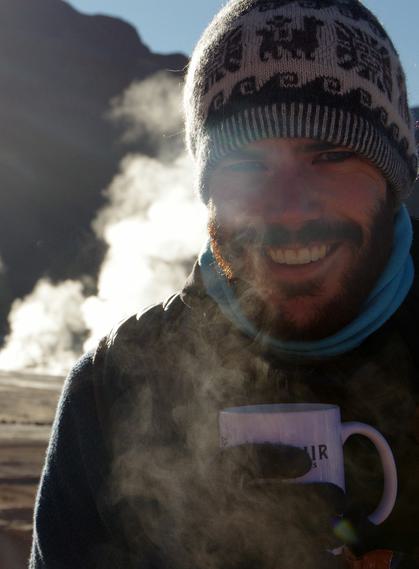Blog
5 Best Road Trips in Spain & Portugal
If you love the sense of discovery which comes with exploring by car, you'll love our road trip vacations in Spain and Portugal.
A group of Pura travelers playfully refer to these sorts of trips as 'WWF'. That has nothing to do with pandas (or wrestlers) and everything to do with the combination of Walking, Wine and Food which weaves its way through them all. So whilst they are driving vacations by name, they are indulgent, slow, beautiful journeys rooted in nature, local culture and delicious food.
If that sounds good to you, and with the below map as a reference, let's jump straight in and share our top 5, starting on the north coast...

Northern Spain: San Sebastian to Santiago
Basque pintxos | Rioja wine | Picos de Europa mountains | Galician beaches

Where: This is the blue route on our map. From San Sebastián, near the French border, it carries us 700km clear across the north coast to Spain's great pilgrim city, Santiago de Compostela. The route passes from the Basque Country into Cantabria, Asturias and Galicia over the course of three unforgettable weeks. Two if you start in Bilbao.
Why: A common theme of these routes will be variety and this one scores big on that front. Variety of scenery - mountains, vineyards, forests, and some of Spain's most beautifully wild beaches. Variety of culture - Basque markets to Asturian cider houses to the pilgrim trails of Galicia. Variety of food - from pintxos (effectively Basque tapas on toothpicks) to the hearty fabada stews of rural Asturias and Spain's most celebrated seafood on the Galician coast.
The big-hitting cities such as Bilbao, San Sebastián and Santiago are balanced with time in properly old-fashioned fishing villages and little medieval towns tucked away between forested valleys. Hikers will love the big mountains of the Picos de Europa, where the million-dollar views come with just about enough effort to make you feel like you've earned your dinner. Wine lovers will be at home in Rioja.
When: This road trip is great for spring, or in September when the wine harvest is in full swing in Rioja. You can get away with July or August, but it will be busy in certain hotspots and the Spanish sun will be out in full force. Winter is a bit wet and wild for our tastes.
How: Our Northern Spain Signature Drive has 10, 14 and 21-day options as starting points which can be tailored for you. I'd advise you aim for 14 days as a minimum if you can as it lets the trip breathe a little and gives you more time to see everything at a slower pace. From the UK you can easily fly to Bilbao, and back from Santiago. Better yet, consider a train from London to Paris to connect with the TGV to the Spanish border. From North America, you can take the train to Bilbao from Madrid or Paris and at the end take a 3-hour train from Santiago to Madrid and return from there.
Pyrenees: San Sebastián to Cadaqués
Pyrenees mountain walks | Medieval towns | Catalan cuisine | Dalí landscapes

Where: The orange route goes east from San Sebastián, traversing the entire Pyrenees mountain range along the France-Spain border until the peaks sink into the Mediterranean Sea on the Costa Brava. From the Basque Country, the route passes through the old kingdoms of Navarre and Aragón before finishing in Catalonia.
Why: You'd think a Pyrenees road trip is all about the mountains. And it is, to some extent. The peaks are always there, always beautiful. You absolutely cannot come to this part of the world and not bring your walking boots. Some of the day hikes are utterly, jaw-droppingly, spectacular. The trails range from easy to challenging, so it's very much walking more than trekking.
But there is a cultural dimension to this trip that underpins it all. That comes in many forms - tales of shepherds driving their flocks along ancient livestock routes in the little-known 'badland' deserts of Bardenas Reales; tiny mountain chapels built during the Reconquista, when Christian kingdoms sought to reclaim Iberian lands from Muslim rule; the colorful life and times of Salvador Dalí, who was inspired by the light and landscapes along the coastline from Cadaqués.
When: Once again, spring is a beautiful time to visit with snow on the peaks and wildflowers in the meadows. The forests of the high Pyrenees turn beautiful tones of ochre and red in fall, from late September through October.
How: Our Spanish Pyrenees Signature Drive can be anywhere from two weeks to a month if you have the time. A 3-week trip lets you start in Bilbao and end in Barcelona without having to rush things. As before, it's easy to connect to the start of this trip by train from London, Paris or Madrid. Ending in Girona or Barcelona means you can do likewise at the end.
Catalonia: Barcelona to El Priorat
Gaudí architecture | Cava vineyards | Priorat wineries | Tarragona's Roman ruins

Where: This is the purple route and the shortest of our five road trips. It spans just 150km from Barcelona to the lesser-known vineyards of El Penedés and El Priorat, via the old Roman city of Tarragona on the Mediterranean coast.
Why: Hands up if you've heard of the Penedés or Priorat wine regions. Keep them raised if you've ever considered visiting either of them.
El Penedés produces around 90% of the country's Cava sparkling wine, a heartland of wineries old and new, large and small. Nestled between the coastal hills and the Mediterranean Sea, it boasts a winemaking tradition dating back over 2,000 years, making it one of the oldest wine-producing regions in Europe. In a 2014 New York Times article, Cava was described as a drink “at best cheap and cheerful, at worst a headache in a glass”. It’s not until you come here that you discover that they keep the good stuff for themselves - in the 2024 edition of the ‘50 Great Sparkling Wines of the World’, a Cava came out on top with a score of 97/100. Nine Cavas made the list in total.
By contrast, El Priorat is a mountainous region of black-slate hillsides, Catalan stone villages and small terraced vineyards, protected by the great mountain amphitheatre of the Serra de Monstant ridge. The focus here is on deep, full-bodied reds packed with flavor. El Priorat still flies under the tourist radar, despite being the only region other than Rioja to hold Spain's elite DOCa+ classification.
When: If we had free reign, we'd be here in September when harvest season is in full swing. October brings lovely fall colors in the vineyards, whilst spring is a lovely time to be anywhere in Spain.
How: Our Barcelona & Catalan Wine Route can be folded into a longer Catalonia self-drive itinerary (bringing in some of the elements from the Pyrenees trip above). Note that although it's a driving vacation, we make sure the wine days don't require you to get behind the wheel. That would be cruel. This is also a great no-fly option by taking the train one or both ways to Barcelona via Paris.
Andalucia: Seville to Granada
Moorish wonders | White villages | Flamenco | Olive groves

Where: This is the dark blue line which loops through southern Spain, close to the Portuguese border. Any trip here usually blends time in the great cities like Seville, Córdoba and Granada with a boutique hotel in a quintessential white village and the warm hospitality of countryside farmhouses nestled amid a sea of olive groves or sprawling chestnut forests. The very best trips do a bit of it all.
Why: Andalucía takes its name from the old Arab kingdom of Al-Andalus. It is this Moorish heritage, overlaid with the footprint of zealous Christian monarchs, for which the region is best known. The Royal Alcazar of Seville, the mighty Alhambra complex which overlooks Granada and the sea of red and white horseshoe arches of Córdoba's Mezquita are world famous.
But a road trip through Andalucía reveals the true extent of their legacy, which accounts for so much of the romantic color, exotic flavors and architectural masterpieces that stir the imagination. Oranges, lemons, almonds, dates and rice, plus spices like saffron, cumin and cinnamon all crossed the Strait of Gibraltar with the settlers. Irrigation systems, developed by the Romans, reached their peaks and exploded the scale of olive harvesting.
And then there are the hilltop villages. Typically built as early Middle Age fortresses, under the watch of the Moors they assumed their now familiar aspect; pretty whitewashed houses and internal patios rising and falling along undulating streets, encircled by stout walls.
Before them came the Romans, after them the Christians. Together, it creates a land of plenty, known for the quality of its olive oil, air-cured ham, wild mushrooms, seafood and artisan cheese. Winegrowing remains at its heart too, from the traditional sherry bodegas to small vineyards cultivating grapes just like the Romans did.
When: Spring and fall are the times to aim for once again. Summer is way too hot. Winter is possible, but it does rain from time to time. Wine harvest is usually early September, whilst late October brings the start of the olive harvest, still done by hand across the region.
How: Our Andalucía Signature Drive is one of many options we have for the region and can range from two weeks up to a month and beyond. We also have several shorter trips combining one of the great cities with one of its great hidden gems, so you get the best of both worlds.
Portugal: Porto to Lisbon
Vibrant cities | Douro vineyards | Hilltop villages | Atlantic coast hiking

Where: From Porto to Lisbon, along the scenic route. Whilst it's possible to drive between Portugal's two great cities in three hours with a fair wind, we prefer to stretch it out over two or three weeks. Who's in a hurry? Going the 'wrong' way north takes you up towards the Spanish border to the historical Minho region. From here you loop down to the vineyards of the Douro Valley and into Alentejo. Crossing the region takes you from hilltop towns to the wild Atlantic coast before heading up to Lisbon.
Why: Portugal has a long and colorful history. For a country that has seen so much change, it is in many ways the more timeless aspects which most appeal to visitors. From the tranquillity of rural Alentejo, dotted with cork oaks, to the splash of ‘rabelo’ boats plying the waters of the Douro, large parts of the country feel like you have stepped back in time - though these contrast strongly with the contemporary buzz of urban Porto and Lisbon.
Its compact size - and largely empty roads - mean that you can see and experience a great deal of its variety without lengthy travel time. From medieval fortresses perched on hilltops to rugged coastline and centuries-old wine estates, the diversity of culture, food and architecture is reflected in the landscapes at every turn.
When: You guessed it, spring and fall. Spring brings beautiful wildflowers and the world's only sea-nesting white storks on the Atlantic coast. September is harvest time in the Douro Valley. The summer is simply too hot, the winter a little bit too wet.
How: Our Portugal Signature Drive showcases what you can do with two or three weeks on the road. As with every trip, it can be adapted to your timeframes of course. A trip of a similar scope would also allow you to combine either the north or the south with some of our favorite parts of Spain. We also have shorter self-drive trips which fit into a week or so. Have a look at our Portugal vacations for our full range.








 By
By 
